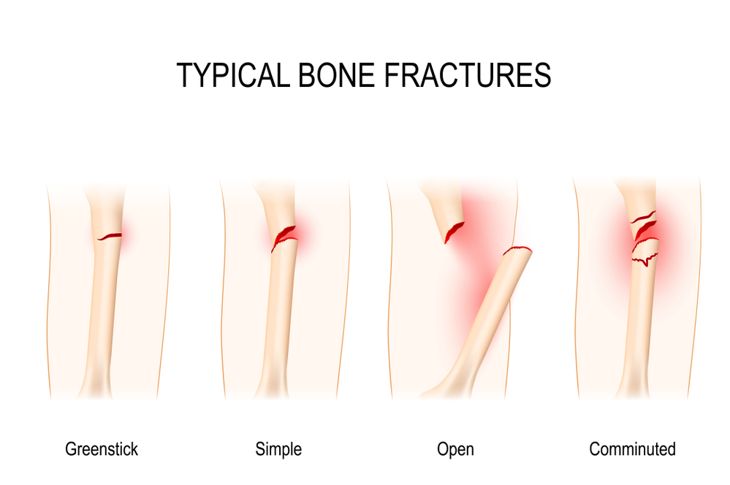Bones are designed to be strong and withstand a certain amount of stress. They can bend a little to prevent injury. However, if the force is too great, bones can fracture — a break in the bone. This may appear as a crack that penetrates partway through the bone, or the injury may snap the bone entirely. There are various types of bone fracture. Comminuted fractures occur when the bone breaks into more than two fragments.
Causes
It takes a lot of force to cause a bone to break. It takes even more force to shatter it into several fragments. Therefore, comminuted fractures are usually caused by high-impact injuries. Road traffic collisions occurring at higher speeds are a common cause of comminuted fractures. This type of break is also often seen after a fall from a significant height. Gunshot injuries can also lead to comminuted fractures.
Symptoms
Comminuted fractures are painful. The person is unlikely to be able to move the injured part of the body and attempting to do so usually causes worse pain. The area surrounding the fracture is likely to appear bruised and swollen. Comminuted fractures can also cause the bone to appear deformed. Depending on the location of the injury, the fractured area may appear bent out of its usual shape. Some comminuted fractures may cause pieces of bone to protrude through the skin. This is an open fracture.
Diagnosis
A doctor will first conduct a medical examination. They will ask the person to describe their symptoms and to explain their injury. If the person has had a serious physical trauma, the doctor may suspect a comminuted fracture in particular. Comminuted fractures require x-rays for a definitive diagnosis. The image allows the doctor to see the affected bone clearly and assess the extent of the fracture. This can also help plan the most appropriate treatment.
Surgical Treatment
Unlike many other breaks, immobilization techniques such as splints and casts are not usually adequate to treat comminuted fractures. Instead, the person will most likely need open surgery. During surgery, surgeons will put the fragments of bone back into their original position. They will then either screw them into place or affix metal plates to the outside of the bones. Depending on the size and location of the fragments, they may also insert a metal rod down the center of the bone fragment.
Recovery
After open surgery for a comminuted fracture, a medical practitioner will usually immobilize the bone using a cast or splint. This prevents the bone fragments from moving while they are healing. Doctors can prescribe pain medication to manage discomfort following surgery. The bone can take six to eight weeks to heal or even longer, depending on the severity. The person will likely have to minimize activities using that body part for some time, even after removal of the cast.
Complications of Comminuted Fractures
Complications can develop following a comminuted fracture, especially if medical treatment is not prompt or there is a misdiagnosis. Potential problems include blood clots in the vessels surrounding the injury site. Infection can also occur, which is more likely if a fragment of bone has pierced the skin. The tissues around the fracture, including muscles and skin, can also suffer injury. If damage causes bleeding into a nearby joint space, this can cause inflammation.
Risk Factors
Having a medical condition such as osteoporosis that makes the bones fragile increases a person’s risk of a comminuted fracture. People over the age of 50 are more likely to receive this type of injury, as bone strength usually decreases with age. More extreme hobbies and activities carry a higher risk of comminuted fractures because high-impact trauma is a common cause. Driving without due care and attention or at high speeds can also lead to serious accidents and fractures.
Prevention
Prevention of comminuted fractures is difficult because they often result from accidents following unforseen circumstances. However, any measures that increase overall bone density and strength can help prevent comminuted fractures. Eating a diet rich in calcium and vitamin D can promote bone strength. Weight-bearing exercise routines can also make bones stronger and less likely to fracture.
Physiotherapy
People with comminuted fractures may benefit from physiotherapy. Most people with this type of injury will have a cast that cannot be removed, so a therapist can assist the person in finding ways to move around and perform simple tasks safely. This is particularly important if the cast is on a lower limb, as moving around becomes difficult. After the cast is removed, it is likely that the person will experience reduced muscle strength and range of movement. A physiotherapist may recommend exercises to restore normal strength and motion in the affected area.
Prognosis
Most people with a comminuted fracture make a full recovery. However, they are likely to experience some loss of function in the affected area which can take months or longer to revert. More rarely, the person may be left with some permanent loss of function if the injury was very severe. Quick treatment significantly improves the prognosis. Complying fully with recovery instructions can also promote quicker and more complete healing.

 Home
Home Health
Health Diet & Nutrition
Diet & Nutrition Living Well
Living Well More
More




















